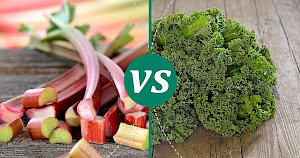Kale vs Rhubarb: Calories & Nutrition Showdown


Kale vs Rhubarb
Nutrition Facts
Serving size:
change
5g10g15g20g30g40g50g60g80g100g120g140g160g180g200g220g250g300g350g400g450g500g600g700g800g900g1000g
1oz2oz3oz4oz5oz6oz7oz8oz10oz12oz15oz20oz25oz30oz35oz40oz50oz
Amount Per Serving:
Serving size:
change
5g10g15g20g30g40g50g60g80g100g120g140g160g180g200g220g250g300g350g400g450g500g600g700g800g900g1000g
1oz2oz3oz4oz5oz6oz7oz8oz10oz12oz15oz20oz25oz30oz35oz40oz50oz
Amount Per Serving:
Kale vs Rhubarb 100g Compare
| per 100g | Kale | Rhubarb |
|---|---|---|
| Calories | 49 | 21 |
| Carbohydrates | 8.75 g | 4.54 g |
| Fat | 0.93 g | 0.2 g |
| Dietary fiber | 3.6 g | 1.8 g |
| Protein | 4.28 g | 0.9 g |
| Calcium | 150 mg | 86 mg |
| Iron | 1.47 mg | 0.22 mg |
| Magnessium | 47 mg | 12 mg |
| Phosphorus | 92 mg | 14 mg |
| Potassium | 491 mg | 288 mg |
| Sodium | 38 mg | 4 mg |
| Zink | 0.56 mg | 0.1 mg |
| Vitaminium A | 9990 µg | 102 µg |
| Vitaminium B1 (Thiamine) | 0.11 mg | 0.02 mg |
| Vitaminium B2 (riboflavin) | 0.13 mg | 0.03 mg |
| Vitaminium B3 (Niacin) | 1 mg | 0.3 mg |
| Vitaminium B5 | 0.091 mg | 0.085 mg |
| Vitaminium B6 | 0.271 mg | 0.024 mg |
| Vitaminium B9 (Folic acid) | 141 mg | 7 mg |
| Vitaminium C | 120 mg | 8 mg |
| Vitaminium K | 704.8 µg | 29.3 µg |
| Beta karoten | 5927 mg | 61 mg |
Exploring the Greens: Kale and Rhubarb
When it comes to choosing nutritious vegetables for your diet, kale and rhubarb stand out for their health benefits and distinctive flavors. Both have been celebrated through the ages, not just for their culinary uses but also for their nutritional profiles. Kale, a member of the cabbage family, has been dubbed a superfood due to its dense nutrient content. Rhubarb, on the other hand, is often thought of as a fruit due to its common use in desserts, but it's actually a vegetable with its own set of nutritional advantages.
A Closer Look at Kale
Kale is renowned for its high levels of vitamins and minerals, including Vitamin A, Vitamin K, calcium, and iron. It's a versatile green that can be used in everything from salads to smoothies. With just 49 calories per 100 grams, it packs a hefty nutritional punch. Kale's rich antioxidant content, including beta-carotene, makes it a powerful ally in promoting overall health and fighting inflammation.
Rhubarb: More Than Just a Pie Ingredient
Rhubarb might be best known for its role in sweet treats, but it deserves recognition for its nutritional value as well. It's low in calories, with just 21 calories per 100 grams, and contains a respectable amount of dietary fiber. Rhubarb also provides vitamins and minerals such as Vitamin K and calcium, although in smaller amounts compared to kale. Its tart flavor makes it a unique addition to both sweet and savory dishes.
Nutritional Face-Off
Comparing kale and rhubarb side by side reveals significant differences in their nutritional profiles. Here's a breakdown of what each offers per 100 grams:
- Calories: Kale has more calories at 49, while rhubarb has only 21.
- Carbohydrates and Fiber: Kale offers more carbs (8.75g) and fiber (3.6g) compared to rhubarb's 4.54g of carbs and 1.8g of fiber.
- Protein and Fat: Kale is higher in both protein (4.28g) and fat (0.93g), whereas rhubarb contains minimal amounts (0.9g protein and 0.2g fat).
- Vitamins and Minerals: Kale outshines rhubarb in most vitamins and minerals, including Vitamin A, Vitamin C, and Vitamin K, along with calcium, iron, and magnesium.
While kale seems to lead in the nutritional showdown, it's important to note that rhubarb's lower calorie count and unique flavor profile make it a valuable addition to a balanced diet, especially for those looking to manage their calorie intake.
Integrating Kale and Rhubarb into Your Diet
Both kale and rhubarb offer distinct flavors and health benefits that can enhance your meals. Kale's robust nature makes it ideal for sautéing, blending into smoothies, or adding to soups. Rhubarb, with its tartness, works well in desserts, but can also add a unique twist to savory dishes. The key is to balance their flavors and nutritional benefits with other ingredients to create wholesome, delicious meals.
In conclusion, while kale might have the upper hand in terms of sheer nutrient density, rhubarb offers its own set of nutritional benefits and culinary uses. Incorporating a variety of vegetables like kale and rhubarb into your diet can help ensure you're getting a broad spectrum of nutrients and flavors. Remember, the best diet is a diverse one, filled with all the colors of the vegetable rainbow.
Kale 100g
49kcalCalories source
- 58% CARBS.
- 28% PROTEIN
- 14% FAT
Rhubarb 100g
21kcalCalories source
- 77% CARBS
- 15% PROTEIN
- 8% FAT
Compares of kale
- Kale vs Artichoke
- Kale vs Arugula
- Kale vs Asparagus
- Kale vs Beetroot
- Kale vs Bitter Melon
- Kale vs Bok Choy
- see all compares of kale
Compares of rhubarb
Read also:
- Calories from Kale
- Calories of Kohlrabi
- Calories in Leek
- Lettuce calories per 100g
- Lima beans protein per 100g
- How many calories does lotus root have?
- Calories in a half of mustard greens leaves
- Calories in whole mustard greens leaves
- Calories for one, two or more mustard greens leaves
- Calories in handful of mustard greens leaves
- How much protein in okra?
Marcin Piotrowicz
calories-info.com creator
Healthy diet and healthy lifestyle promoter
Add comment